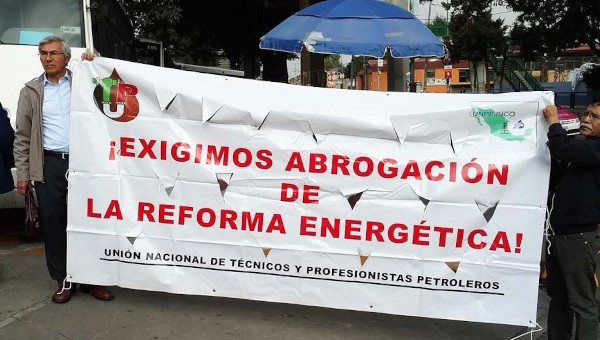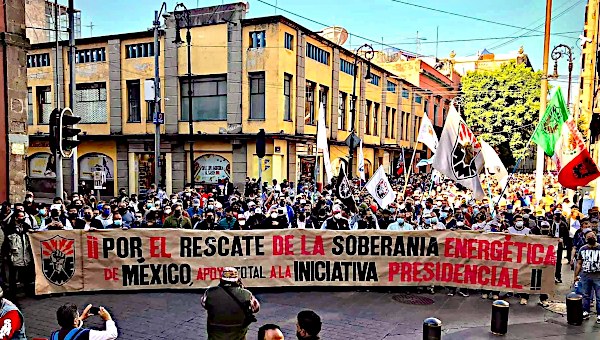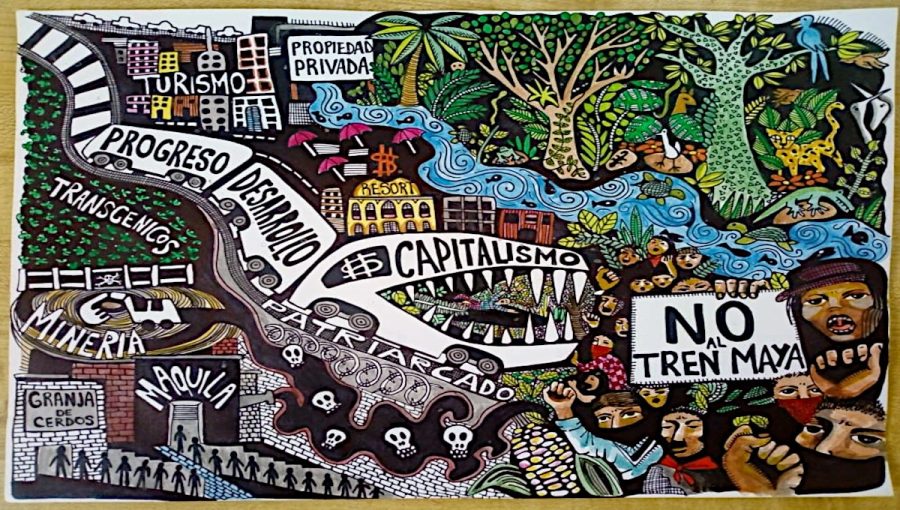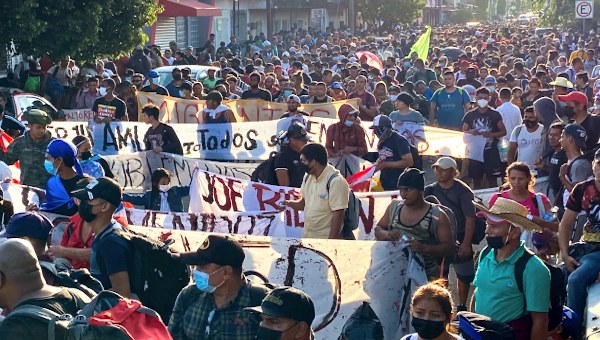State Terror and the Murder of 43 Students
The Mexican government, welcomed as a partner of the Canadian and U.S. governments in continental economic development (North American Free Trade Agreement – NAFTA) and
continental security also happens to partner in crime and the slaughter of its own people. The murders and disappearances of the students from the Rural Normal “Raúl Isidro Burgos,” of Ayotzinapa, Guerrero, Mexico on September 26, 2014 in Iguala, was a crime of the State, as hundreds of thousands of Mexicans have claimed in their protests. The governmental investigation that followed the September 2014 attack on these students has been deliberately incompetent and not aimed at getting to the roots of the crime as these roots, in fact, are the tangled web of state-drug gang corruption and the state’s dirty war in defense of the neoliberal
transformation of Mexico. The investigation has been staged, quite ineffectively, as a public relations operation to calm foreign investors and to cool out protest, efforts that have completely failed within Mexico. By claiming that the blame was at the local
level, the corrupt collusion of a local mayor and his avaricious wife with a brutal cartel, it seeks to present itself, the national government, as the defender of justice.
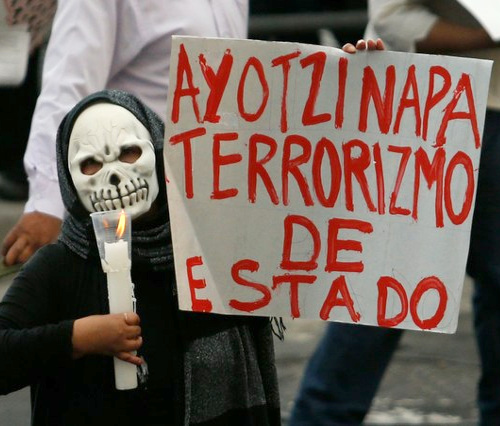
But as Luis Hernández Navarro shows in his article, “La matanza de Iguala y el Ejército,” (The Iguala Massacre and the Army), there is – and has long been – a deep entanglement between the Army, the local government of
Iguala, and drug production. Sixty per cent of the Mexican production of poppies and opium gum for making heroine comes from the state of Guerrero. The cities of Iguala and Chilpancingo are key centers for its storage and transportation. The Army is viewed by many as the real government of the state, a state with a history of guerrilla groups, militant protests and a long dirty war carried out by the army. As Francisco Goldman wrote in the New Yorker:
“The Mexican Army, according to many journalists and other commentators, is the real government authority in Guerrero State. ‘The army knows that state millimetre by millimetre,’ a Mexican legislator pointed out in a recent speech, ‘and they know minute by minute what’s happening there.’” (“Crisis in Mexico: The Protests for the Missing Forty-Three,” The New Yorker.)
Intertwining of Government, Army and Drug Gangs
The intertwining of the government and armed forces with the drug gangs has a long history in Guerrero. Plaza Tamarindos in Iguala, a retail commercial center, built on land donated by the armed forces to José Luis Abarca, sits across from the military barracks. Abarca, now under arrest, accused of
ordering the attack and having links to Guerreros Unidos, the drug gang, had been accused of ordering the murder of three protesters earlier. The investigation was not pursued. And Colonel Juan Antonio Aranda
Torres, commander of the 27th Battallion, stationed in Iguala, claimed that he and his troops knew nothing of the attacks, though they took place within 100 meters of the army barracks. At the time, he was attending a fiesta organized by María de los Ángeles Pineda Villa, the wife of Mayor Abarca, now also accused of ordering the attack and being connected to drug gangs. Though Aranda Torres was trained as an intelligence and counter-intelligence officer, he claims, like the three wise monkeys to have seen nothing, heard nothing, and he certainly has said nothing. (“La matanza de Iguala y el Ejército,” The Iguala Massacre and the Army).
This was not an isolated event. Unfortunately, torture, killings, and assassinations have become commonplace in Mexico with different levels of the police or armed forces involved as well as drug gangs. The 27th Battallion participated in the dirty war of the 1970s and 1980s. And Human Rights Watch, in a 2011 report, “Ni Seguridad, ni derechos” (Neither Security nor Rights) wrote that there is strong evidence that the 27th Battallion participated in the disappearance of six young people in Iguala in March 2010. These state crimes against humanity, sadly, are the rule not the exception in Mexico. Several months earlier, in June, 2014, the federal army carried out a mass execution of 22 young people in the same region, in the town of Tlatlaya, in the neighboring state of Mexico. The army and the federal government then attempted to cover up these executions in Tlatlaya. After journalists and human rights groups exposed the cover-up and mass execution, the government arrested some low ranking soldiers.
Though we may never know the immediate motives for the killings and disappearances of the teachers’ college students, we do know that there has been a pattern of ruthlessly
destroying opposition to the neoliberal transformation of Mexico. This has been as true in the sphere of education as it has been in natural resource development. The push by the World Bank as well as the key organizations of business in Mexico – as is also happening
in Canada and the U.S. – to destroy teachers’ unions, teachers’ rights and privatize education, has led to an intensification of the attacks on the normales, the rural teachers colleges, attacks that have been underway for several decades but have recently intensified. The Rural Normal “Raúl Isidro Burgos,” was part of a system of teachers’ colleges set
up to recruit students from poor rural communities to become teachers and community organizers, a system that was established during the Cárdenas presidency (1934-1940). These schools have a history of developing community leaders and union activists as well as a tradition of fighting for social justice and for the preservation of the land rights of their communities. Seventeen of the original 33 normales have already been shut down in spite of militant resistance from students,
alumni (many of whom are involved in the dissident teachers’ movement, and the local communities. Ironically, the students from the Rural Normal “Raúl Isidro Burgos” were only passing through Iguala en route to near-by Mexico City to participate in the annual October 2 march commemorating the 1968 massacre of student protesters in Mexico City.
The use of violence by the government, including torture, killings, and even massacres, has a long history in Mexico that predates the rise of the drug gangs and the neoliberal
offensive. These events, however, should not be viewed as simply related to the internal dynamics of repression, resistance and the drug wars in Mexico. They are closely related to the neoliberal transformation imposed on Mexico by its own capitalist class and state in conjunction with the capitalist classes and states of Canada
and the United States and, most vividly expressed in NAFTA (Roman and Velasco Arregui, Continental Crucible: Big Business, Workers and Unions in the Transformation of North America, 2013). The killing fields and investment opportunities in Mexico are intimately related. They don’t exist on different planets. The neoliberal capitalist transformation of the Mexican economy requires repression to prevent or quell resistance to the massive destruction of
socio-economic rights, livelihoods, and hope for a better future. The killing fields of Mexico help reduce interference with the ‘free market’ transformation of Mexico. Just as the neoliberal transformation of Chile came through the bloody repressions of the
U.S.-supported dictator, so the neoliberal transformation of Mexico is accompanied by the bloody slaughter of tens of thousands of Mexicans. The Mexican killing fields are not the bloody handiwork of the drug gangs alone; in fact, the interlacing of the various drug gangs with the various levels of the government, army, and police make it difficult to know where one begins and the other ends. There
is a brutal war going on in Mexico but it cannot be seen simply as a war of the government against the drug gangs as the two are interlaced in a variety of ways and symbiotically linked. Only part of the violence against ordinary people, journalists, and
community activists is related to the struggle within the government-army-drug gang institutional complex over turf and transportation routes. Much of the violence is an intensification of the dirty war of the 1970s, a war against the Mexican people carried out by the government to defeat resistance to the regime in the ‘70s and now being carried out to discourage or defeat resistance to Mexico’s neoliberal transformation.
Open for Business
While the most powerful business organizations in North America – Business Roundtable (BRT), the Canadian Council of Chief Executives CCCE), and the Consejo Mexicano de Hombres de Negocios (CMHN) propose deeper and closer ties within North America, the Mexican state continues terrorizing its own population. The image of Mexico promoted by these three peak business organizations, their related think-tanks and the three governments (of North America) is that of a
Mexico at the edge of a great leap forward in economic development, democracy and socio-political stability, developments being propelled by the ‘opening of Mexico’ and the ‘free market’. The punishing reality for the vast majority of Mexicans is state-enacted
and state-tolerated slaughter of its own population to complement deteriorating living standards, deteriorating social rights, the loss of land rights, and the sell-off of natural resources. Mexico has been en route to becoming a paradise for foreign investors and a hell
for the vast majority of Mexicans. The Constitutional reforms passed in 2013-2014 and their implementing legislation have opened Mexico’s oil to private development as well as increasing the ability of the government and mining companies to dispossess rural communities from their lands. The attack on the rights of the Mexican people will be sped-up by these recent reforms unless they are derailed by the growth of the already massive popular response to the massacre.
The capitalist offensive in North America and its particular expression in Mexico is a major part of the explanation of the bloody state of Mexican society. Much of the violence is either being carried out – or being used opportunistically – as part of a
strategy of dispossession in the interests of domestic and foreign capital, particularly that of the resource sector. Much of the violence is being carried out by the Mexican government. The extreme brutality of the violence, whether initiated individually or jointly
by state agents or gangs facilitates – intentionally or as a convenient side-effect – the clearing of areas and the dispossession of their populations for private development of resources.
The armed forces, which carry out much of the violence against the civilian population, are linked both to drug gangs and to the U.S. government which provides massive military aid and training through Plan Mérida. The drug wars,
fights within the drug gangs-state complex, provide a cover for the Mexican state’s intensification of its pre-existing dirty war aimed at preventing civil resistance or quelling it quickly. Much of the resistance being smothered is resistance to the neoliberal transformation of Mexico.
The complicity of the government in carrying out or tolerating a state of terror against society is (well) described in a recent statement by Human Rights Watch discussing the tidal wave of disappearances in Mexico since 2006. The sub-heading of the statement describes the efforts of the government as involving “Inexplicable Delays, Contradictory Statements, Limited Results.”
“No one has been convicted of an enforced disappearance committed after 2006, according to official information. Between 2006 and 2013,
authorities opened 99 criminal investigations for the alleged crime of enforced disappearance at the federal level, and 192 at the state
level. During this time, only six people were convicted for the enforced disappearances of seven victims, all of these involved cases that had occurred before 2006.”
Officials in the special unit told Human Rights Watch that even though the attorney general had made this effort a priority, they did not have sufficient resources to handle their large caseload. Yet in September, the government announced that it would cut the special unit’s budget by more than 60 per cent, according to press accounts.
“Without adequate support, it will be impossible for prosecutors charged with this monumental task to succeed in finding the missing and bringing perpetrators to justice.”
The situation is similar for killings and for the femicidio that has been taking place in Mexico since 1994, especially in Ciudad Juárez.
Formal Governmental Institutions and Shadow Institutions of Power
Mexico’s culture of impunity has to be understood as an important element in a power system of alliances between caciques (political bosses), government officials, military and police officers, businessmen and, more recently, drug gang bosses, a system of interlacing of formal governmental institutions with shadow institutions of power. The power structure was more monolithic in the days of the extremely powerful central state institutions during
which the President could impose his power on Governors, Mayors, the Supreme Court, the national Congress. Deals could be imposed on rival political factions and shadow groups. The break-up of the national power of the one-party state through electoral competition, albeit constrained and corrupt, the sharply increased power at the sub-national levels of municipalities and states, the deliberate neoliberal-inspired policies of weakening the regulating power of the national state, were accompanied after the ’90s by the break-up of
the centralized hierarchical structure of the drug gangs. The 1990s witnessed the development of a handful of major drug gangs and growing conflict among them. The continuing fragmentation of the drug gang structure into many gangs at different levels has involved the
intensification of warfare among the gangs and their varied government partners at different levels. This fragmentation has created a more pluralistic, more violent and more brutal struggle for controlling plazas (shipping nodes) and production in the drug industry as well as a diversification of activities into production of other commodities (eg, mining in the state of Coahuila) and protection (Michoacán – iron ore to China), kidnappings and a variety of other criminal activities.

The Mexican national state has become more repressive while at the same time increasingly losing its monopoly on coercive power. The armed forces of the national state have grown tremendously since the Zapatista uprising of 1994. The army grew from 216,000 in 1994 to 266,000 in 2014 (212,000 members of the army and 54,000 of the Navy). If we add the 57,000 members of various federal security agencies, which include 40,000 members of the counter-insurgency national police force, the PFP, created in 1999 largely from officers and soldiers from the armed forces and the five thousand members of the new federal gendarmerie, the federal forces now amount to 323,000 members.
However, there are several inter-related processes that undermine the monopoly on violence of the national state: 1) the fusion and/or co-optation by the drug gangs of local governments, including police forces, as well as sections of the national police and armed forces, in effect a form of privatization of violence/coercion – municipal and state police forces, funded locally and poorly paid, have grown from 95,272 people in 1980 to 503,753 in 2010; 2) the growth of private-for-profit military forces working for big business (domestic and foreign) and the rich to protect them against sections of the state-cartel complex or to keep workers or local communities in line. The number of these private security personnel officially
recognized by the government is around 60,000; 3) the massive size of well-armed drug gangs, now estimated to be about 500,000, though divided into many different irregular armies and, 4) the significant and escalating growth of non-governmental community self-defense militias. Many of these militias are genuinely community-based organized and have organized themselves to protect their communities against the violence of the army and gangs. Others started as or have been co-opted to be power instruments of local political bosses or economic elites. And yet others have been developed by the government as counter-revolutionary para-military forces. Mexico is a society in arms with most of the arms in the hands of state and private forces that continually carry out human rights violations with impunity.
The Missing Forty-Three
The atrocities of September 26, 2014 at Iguala, Guerrero shocked Mexican society as never before. Though Mexicans are sadly accustomed to constant reports of disappearances, killings and mass graves, this event was the straw that broke the camel’s back. Shock was followed by outrage and protests grew weekly, especially those of other college and university students. And the tenacious militancy of the parents and relatives of the 43 missing students, continuing to demand that their sons be returned alive has inspired the protesters.
Fighting tears and clinging to hope, the families of the 43 have been in the forefront of mobilizations. Three caravans of parents and other family members of the 43 have travelled north, south and east and west to meet with other Mexicans, to share stories of losses and repression, and to demand the return alive of the 43. They have received great solidarity on their journey. Today, November 20, the 104th anniversary of the start of the Mexican Revolution,
these three caravans will converge on the Zócalo of Mexico City joined by marches from 3 different points in the city. Other demonstrations will take place throughout Mexico and in many parts of the world.
The national government has tried many tactics to undermine the growing protests. First, they remained silent, then they declared it a local problem, then they feigned great efforts to find the culprits and the missing students, finally they declared the students dead based on nothing but confessions, perhaps under torture, of members of the local drug gang. All of these tactics have backfired and have made people even more indignant. The government’s hope that the protests would fade with time has not happened. The recent revelations that the President received a $7,000,000 house as a gift from a recipient of government contracts has also hit a nerve. The government is now using a classic tactic of the Mexican regime – the use of provocateurs to carry out violent acts in order to prepare the justification for the possible use of violent repression, as the President recently threatened.
The contrasting images in the press of the luxurious gifted home and the telegenic President and his telegenic soap opera star wife on the one hand; and, the faces of the parents and brothers and sisters of the 43, humble rural people from one of Mexico’s poorest states, but brimming with human dignity, tell much of the story of Mexico today, a country of dramatic contrasts and a burgeoning struggle between the barbarism being imposed on Mexico by the drug gangs and the capitalist classes and governments of all three North American countries and the desire for peace and social justice of ordinary Mexicans.
Part II of this article will look at the strengths, vulnerabilities and dilemmas of the protest movement, the tensions between demands for social justice within the regime and the belief of many that a new regime is a necessary condition for social justice. It will also
examine tensions within the regime and the political party system over how to respond to this crisis of legitimacy. As well, it will look at the role that the U.S. and Canada are playing and are likely to play as this crisis unfolds. •


